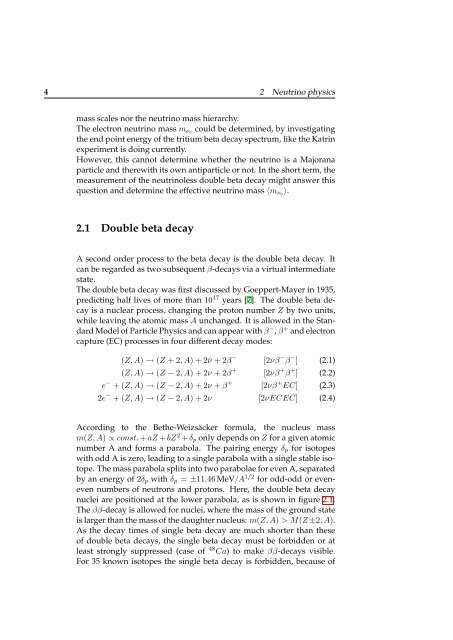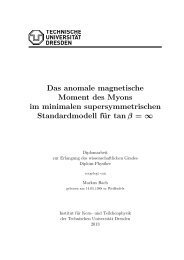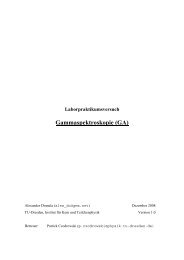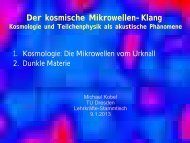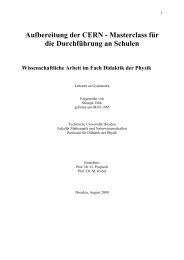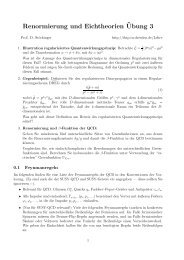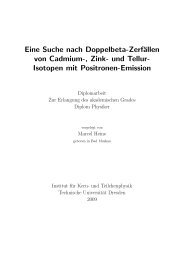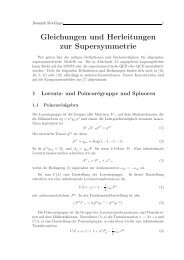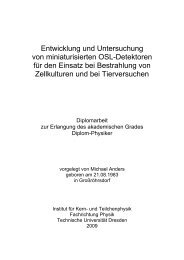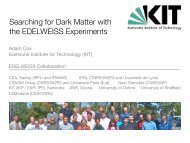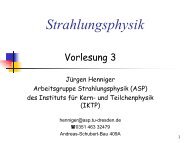a design study for a cobra upgrade to - Institut für Kern- und ...
a design study for a cobra upgrade to - Institut für Kern- und ...
a design study for a cobra upgrade to - Institut für Kern- und ...
You also want an ePaper? Increase the reach of your titles
YUMPU automatically turns print PDFs into web optimized ePapers that Google loves.
4 2 Neutrino physics<br />
mass scales nor the neutrino mass hierarchy.<br />
The electron neutrino mass mνe could be determined, by investigating<br />
the end point energy of the tritium beta decay spectrum, like the Katrin<br />
experiment is doing currently.<br />
However, this cannot determine whether the neutrino is a Majorana<br />
particle and therewith its own antiparticle or not. In the short term, the<br />
measurement of the neutrinoless double beta decay might answer this<br />
question and determine the effective neutrino mass 〈mνe〉.<br />
2.1 Double beta decay<br />
A second order process <strong>to</strong> the beta decay is the double beta decay. It<br />
can be regarded as two subsequent β-decays via a virtual intermediate<br />
state.<br />
The double beta decay was first discussed by Goeppert-Mayer in 1935,<br />
predicting half lives of more than 10 17 years [7]. The double beta decay<br />
is a nuclear process, changing the pro<strong>to</strong>n number Z by two units,<br />
while leaving the a<strong>to</strong>mic mass A unchanged. It is allowed in the Standard<br />
Model of Particle Physics and can appear with β − , β + and electron<br />
capture (EC) processes in four different decay modes:<br />
(Z, A) → (Z + 2, A) + 2¯ν + 2β −<br />
(Z, A) → (Z − 2, A) + 2ν + 2β +<br />
e − + (Z, A) → (Z − 2, A) + 2ν + β +<br />
[2νβ − β − ] (2.1)<br />
[2νβ + β + ] (2.2)<br />
[2νβ + EC] (2.3)<br />
2e − + (Z, A) → (Z − 2, A) + 2ν [2νECEC] (2.4)<br />
According <strong>to</strong> the Bethe-Weizsäcker <strong>for</strong>mula, the nucleus mass<br />
m(Z, A) ∝ const. + aZ + bZ 2 + δp only depends on Z <strong>for</strong> a given a<strong>to</strong>mic<br />
number A and <strong>for</strong>ms a parabola. The pairing energy δp <strong>for</strong> iso<strong>to</strong>pes<br />
with odd A is zero, leading <strong>to</strong> a single parabola with a single stable iso<strong>to</strong>pe.<br />
The mass parabola splits in<strong>to</strong> two parabolae <strong>for</strong> even A, separated<br />
by an energy of 2δp with δp = ±11.46 MeV/A 1/2 <strong>for</strong> odd-odd or eveneven<br />
numbers of neutrons and pro<strong>to</strong>ns. Here, the double beta decay<br />
nuclei are positioned at the lower parabola, as is shown in figure 2.1.<br />
The ββ-decay is allowed <strong>for</strong> nuclei, where the mass of the gro<strong>und</strong> state<br />
is larger than the mass of the daughter nucleus: m(Z, A) > M(Z ±2, A).<br />
As the decay times of single beta decay are much shorter than these<br />
of double beta decays, the single beta decay must be <strong>for</strong>bidden or at<br />
least strongly suppressed (case of 48 Ca) <strong>to</strong> make ββ-decays visible.<br />
For 35 known iso<strong>to</strong>pes the single beta decay is <strong>for</strong>bidden, because of


